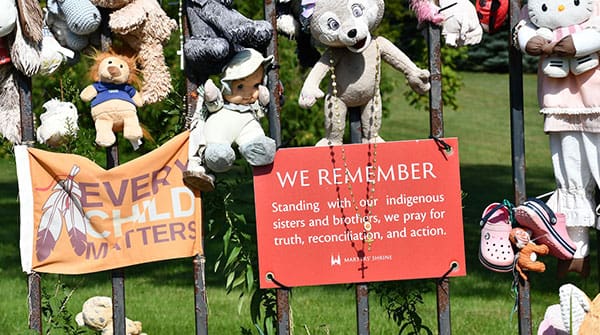Yes, but there is no evidence of anything sinister about the death and burial of even one student at Canadian residential schools

Yes, children died. But there was nothing sinister or evil about any of the deaths; they were simply a fact of life at a time when death from disease was a sad but common occurrence. Children who attended day schools, or no school at all, died in even greater numbers on their home reserves.
Historical records show that children who died while enrolled in a residential school were properly buried, with graves almost always marked with wooden crosses. In many cases, the gravesites and cemeteries were not properly maintained; the wooden crosses deteriorated and blew away, and the burial sites of children – whether they died at residential schools or on their home reserves – were lost in time.
It is true that a small number of the residential school students who died of disease were buried in dedicated residential school cemeteries without their parents present. However, there was nothing sinister about those deaths or those burials.
 |
| Related Stories |
| House of Commons finally describes residential schools as genocide
|
| We must accept the mistakes of the past and make them right
|
| Want justice for Indigenous children? Then demand it
|
These children received Christian burials, and their deaths were properly documented. Only distance and logistical difficulties made it impossible for their parents to attend the funerals. Simply put, there is no credible evidence of anything sinister about the death and burial of even one residential school student.
Stories about murderous priests and secret burials of 215 children, with the forced help of six-year-olds, are simply conspiracy theories that have circulated for years in First Nations communities. Claims of thousands of “missing children” are a distortion of reality.
So, what killed residential school students?
The major killer of Indigenous children – regardless of whether or not they went to school – was tuberculosis. The tuberculosis epidemic was similar in some ways to the sudden emergence of AIDS in the 1980s. AIDS was a frightening, deadly disease. As with tuberculosis, the cause was unknown, and there was no known cure.
Tuberculosis was also similar, in some ways, to the Covid-19 epidemic the world recently went through. Although we knew from the start that a respiratory virus caused Covid-19, it was not at all clear when the epidemic struck what we should do about it.
But tuberculosis was a far bigger killer. As a percentage of the population, it caused more deaths over the centuries than AIDS and Covid-19 combined and was only brought under control when antibiotics were discovered in the 1940s. In 1867, when this country came together as a nation, tuberculosis was the leading cause of death from disease. Even today, in northern areas, such as Nunavut, where tuberculosis rates are alarmingly high, or in developing nations, tuberculosis is still infecting and killing a million and a half people every year.
But on Indian Reserves, in the 19th and early 20th century, the tuberculosis situation was even worse. In fact, some of the prairie reserves had some of the highest tuberculosis rates ever recorded – anywhere. The combination of crowded, unsanitary conditions in the shacks that passed as houses, malnourishment that became endemic after the buffalo were gone, and the lack of understanding by reserve residents about even basic health and sanitation practices resulted in the deaths of thousands of reserve residents. Entire households – and even entire communities – became infected. And too many died.
Other diseases were also major killers. The usual flu epidemics killed Indigenous people regularly, as did scarlet fevers and other diseases. But, for Indigenous people, especially, tuberculosis was the leading killer.
It was from these communities that the residential school students came. Although the exact percentage of how many of these children were infected when they arrived at residential schools is unknown, Chief Medical Examiner Dr. Peter Bryce’s findings are the best evidence we have. According to Bryce, of the eight schools he examined, every child he examined was infected. In other words, tuberculosis started on the reserves, not the schools. The fact that the disease progressed in some of those previously infected children to the terminal stage should surprise no one.
The brutal truth is that those doomed children would have died even if no residential school had ever been built.
Every one of these deaths is sad – whether death came to a residential school student, a day school student, or one of tens of thousands of Indigenous children who never attended any school at all – but there was nothing sinister about any of these sad deaths.
There is also nothing more “missing” about the lost burial sites of the residential school students than any of the lost burial sites of the great majority of the Indigenous children who never went to a residential school but died anyway.
So, why is $320,000,000 being spent trying to find long-lost burial places of “missing” Indigenous children who went to residential schools while absolutely no money is being spent trying to find the lost burial places of the far larger number of “missing” children who never went to residential school, and died from disease in their home communities?
While we are on the subject of misinformation, why are stories being circulated that 215 children at Kamloops were somehow killed and secretly buried – with thousands more similar sinister deaths and secret burials all across Canada – with absolutely no credible evidence to support these conspiracy theories? And why is the federal government rewarding these false claims with millions of dollars, and why is there no real pushback from the mainstream media?
The avalanche of claims about iIndigenous children being murdered, poisoned and secretly buried is now giving way to less dramatic – but equally accusatory – claims that priests, nuns and others were somehow grossly negligent or downright cruel in their treatment of iIndigenous children. These claims include accusations that children died unnecessarily, were carelessly buried by school personnel, and were simply forgotten.
It appears that the activists promoting these claims – with no evidence to support them – realize that people are simply not buying the “murdered and secretly buried” narrative any longer. All available evidence proves that deaths were carefully recorded, and proper Christian burials – usually on the child’s home reserve, with parents present – were the norm. The teachers, priests and nuns of yesteryear were no more or less decent and honourable than their counterparts today. So, why are they being regarded as brutes and villains?
These questions all deserve evidence-based answers.
Brian Giesbrecht, retired judge, is a Senior Fellow at the Frontier Centre for Public Policy.
For more information, visit IRSRG.ca (Indian Residential Schools Research Group), or Professor Hymie Rubenstein’s Substack The REAL Indigenous Issues Newsletter where relevant essays are posted regularly.
For interview requests, click here.
The opinions expressed by our columnists and contributors are theirs alone and do not inherently or expressly reflect the views of our publication.
© Troy Media
Troy Media is an editorial content provider to media outlets and its own hosted community news outlets across Canada.

